Beware of recalled toys still sold online, report says
Loading...
Toys are often recalled for reasons ranging from inappropriate labeling to choking hazards, but a consumer advocacy group says that some of the toys recalled are still available online.
More than a dozen of the 40 toys recalled by the Consumer Product Safety Commission (CPSC) from January 2015 to October 2016, were still being sold online, according to a report "Trouble in Toyland," by the US Public Interest Research Groups Education Fund (PIRG). Some of the products were recalled for containing excessive levels of lead or hosting compartments that pose choking hazards.
“It is a challenge for the commission to get into consumers’ homes,” Nikki Fleming, a CPSC spokesperson told Market Watch. The federal consumer agency operates an internet surveillance team to watch for all products on the PIRG’s list of recalled items.
Concerns about the lack of awareness among parents about toy recalls spiked a decade ago when millions of toys were recalled for containing excessively high levels of lead. While there are systems in place in brick-and-mortar stores that can alert merchants to the status of hazardous toys, federal regulators face more difficulty in preventing such sales in popular online marketplaces where the toys could be resold to unknowing consumers.
“Making recalls faster and more effective remains a challenge. Not enough consumers hear about recalls and not enough of those who do may take action,” the report authors wrote. “We also warn retailers and distributors, as well as resellers, particularly Internet sites, that it is illegal to sell previously-recalled products.”
This occurs as toy recalls have declined, although 2015 still saw 11 reports of toy-related deaths and 254,200 toy-related injuries treated in emergency departments, according to CPSC data.
In the time period examined by the report’s authors, the CPSC recalled more than 40 toys that total over 35 million units. Lead, banned in products marketed to children and considered harmful to children’s health, was found in excessive levels in 11 toys. Other potential hazards include excessive noise, choking hazards, and the presence of banned chemicals.
According to the report, most brick-and-mortar retail stores have inventory control “lock-outs” that prevent a recalled toy found on a shelf to be purchased at checkout. But some large merchant websites and resellers don’t have that safeguard on their online portals.
It’s a problem that was also present in 2007 with the massive lead-tainted toy recall. As previously reported by E Magazine:
The biggest problem with the recall of millions of lead-tainted toys over the last few years has been getting shops and consumers to comply. According to Mattel , which has issued dozens of recalls in recent years (including some 2.2 million Chinese-made toys contaminated with lead paint), historically only about 6 percent of recalled toys are returned. … Of the remaining toys, some of those that were recalled in the summer of 2007 ended up on auction websites like eBay and business-to-business sites like Made-in-China.com – and then eventually into the hands of unwitting consumers, many of them overseas.
A study published in the journal Injury Prevention that year discovered that over a period of 30 days, 190 auctions on eBay contained or were suspected to contain a recalled toy - and 70 percent of auctions resulted in a successful sale.
“Recalled children’s products were found to be available for sale online and were sold most of the time, presenting a risk of injury to children,” the researchers concluded. ”A multi-front initiative to decrease the presence of hazards in online auctions is needed.”
While consumer advocacy groups have pressured online retailers and resellers to ensure recalled toys don’t get sold, the CPSC has also been experimenting with efforts to help equip parents with the latest information, complementing its searchable database of recalls hosted on its website. In 2007, it also launched a “Drive to 1 million” campaign to inform consumers of product recalls through email notifications.








